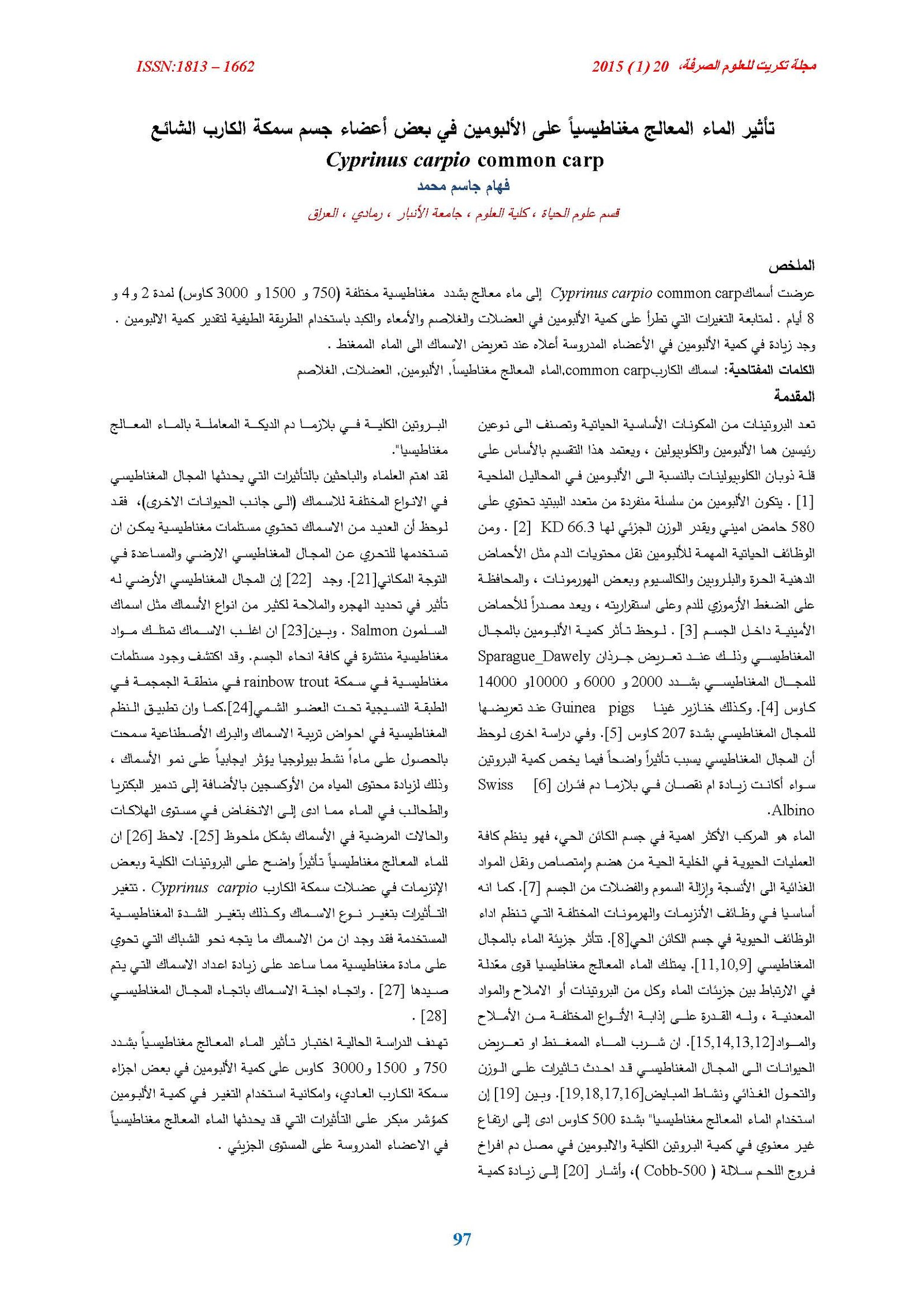Effect of magnetically treated water on the Albumin in some body organs of common carp fish Cyprinus carpio L.
Main Article Content
Abstract
The fish common carp Cyprinus carpio L. were exposed to the magnetically treated water with different magnetic intensities (750, 1500 and 3000 Gauss) for a period of 2, 4 and 8 days.
To follow the changes in the amount of albumin in the muscles and gills and intestines and liver using the spectrophotometric method to estimate the amount albumin. Found an increase in the amount of albumin in the organs after exposure of the fish to the magnetized water.
Article Details

This work is licensed under a Creative Commons Attribution 4.0 International License.
Tikrit Journal of Pure Science is licensed under the Creative Commons Attribution 4.0 International License, which allows users to copy, create extracts, abstracts, and new works from the article, alter and revise the article, and make commercial use of the article (including reuse and/or resale of the article by commercial entities), provided the user gives appropriate credit (with a link to the formal publication through the relevant DOI), provides a link to the license, indicates if changes were made, and the licensor is not represented as endorsing the use made of the work. The authors hold the copyright for their published work on the Tikrit J. Pure Sci. website, while Tikrit J. Pure Sci. is responsible for appreciate citation of their work, which is released under CC-BY-4.0, enabling the unrestricted use, distribution, and reproduction of an article in any medium, provided that the original work is properly cited.
References
1- Annino, J.J. and Giese, R.W. (1979).Clinical chemistry.(4 ed) . Little, Brown and Boston.
2-Tietz,N.V.(1999).Textbook of clinical chemistry. W.B. Saunders compan Philadeelphia, pp.490(491): 1000-1025
3- Bishop, L.; Duben, V.J.L. and Fody, G.P. (1985). Clinical chemistry principles procedures and correlations . J.B. Lippincott, Company, London.
4- EL-Ashry, M. Y.; Ibrahim, M. A. and Ali, E.A. (2008). The influence of 50 Hz magnetic field on Liver enzymes. Suez Canal Univ Med J. 11(1):56-64. 5- Sedghi, H. ; Zare, S. ; Hayatgeibi, H. Alivandi, S. and Ebadi, a. g. (2006). Biological Effects of Power Frequency Magnetic Field on Serum Biochemical Parameters in Guinea Pigs. Pakistan Journal of Biological Sciences. 9(6) : 1083-1087. 6- Kumosani , T.A. and Mohamad, H. Q.(2003). The effect of magnetic field on the biochemical parameters of mice blood . Pak J Sci . 19 (1): 36-40.
8- Goldsworthy, A.; Whitney, H. and Morris, E. (1990). Biological effects of physically conditioned water. Water Research. 33:1618.
9- Nagy, T. and Szilagyi, S.(1996). Anti cancer magnetic therapy. Biotechnology, 57:170-173 .
10- Young , J.W. (1968). Effect of D. and L. thyroxine on enzymes in liver and adipose tissue of rat. Am. J. Physiol. 214(2): 378-383.
11- Hashimoto, S.; Mochizuki, S.; Morita, Y.; Tsutsui, H.; Yoshiura, M.; Akazawa, K.; Ohsuga, M.; Uto, S.; Otani, H.and Fujisato, T.; (2007) .Environmental Design for Muscle Cell Culture with Magnetic Field . EcoSystems and Technologies. 468-472.
11- Koruga, D; Miljkovic, S.; Ribar, S.; Matija, L. and Kojic, D.(2010). Water Hydrogen Bonds Study by Opto-Magnetic Fingerprint Technique. Acta physica polonik . 117(5) : 777-781.
12- Bruns, S.A.; Klassen ,V.I. and Konshina, A.K. (1966). Change in the extinction of light by water after treatment in a magnetic field. Kolloidnyi Zhurnal, 28:153- 155.
13- Joshi, K.M. and Kamat, P.V. (1966). Effect of magnetic field on the physical properties of water. J.Ind. Chem. Soc., 43: 620- 622.
14- Klassen, V.I. (1981). Magnetic treatment of water in mineral processing. In developments in mineral processing, part B., Mineral processing. Elsevier, N.Y. 1077- 1097.
15- Kronenberg, K.J. (1985). Experimental evidence for the effects of magnetic fields on moving water. IEEE Transaction on Magnetic. 21 (3) : 2059-2061.
16-Nafalski, A. (1994). Magnetic water treatment. International conference EIMECO. Electronmagn. Devise processe Environ. Prot. Proceeding. P:161-165.
17- Patterson, D.C. and Chestnut, D.M.B. (1994). The effect of magnetic treatment of drinking water ongrowth, feed utilization and carcass composition of lambs. Animal Feed Science and Technology, 46(1-2) : 11-21.
21- Harada, Y.; Taniguchi, M.; Namatame, H. and Iida, A. (2001). Magnetic materials otoliths of brid and fish lagena and function. Acto Oto- Laryngol.121:590-595
22- Quinn ,T.P. and Ernest, L. B. (1982). The use celestial and magnetic cues by orienting sockeye salmon smolts. J. Comp. physiol.147: 137-142.
23- Hanson, M. and Westerberg, H. (1987). Occurrence of magnetic material in teleosts. Comp. Biochem. Phys. A: Physiology .86: 169–172.
24- Bohannon, J. (2007). michael walker Seeking Nature's Inner Compass. Science. 5852(318): 904-907.
25- Alkhazan, M. and Saddiq, A.(2010). The effect of magnetic field on the physical and chemical microbiological properties of the lake water in saidi Arabiab. J. Environ.Biol.Res.,2(1):7-14.
27- Formicki, K.; Sadowski, M.; Tanski, A.; Korzelecka-Orkisz, A. and Winnicki, A. (2004). Behaviour of trout (Salmo trutta L.) larvae and fry in a constant magnetic field. J. Appl. Ichthyol. 20, 290–294.
28- Tanski, A.; Formicki, K.; Smietana, P.; Sadowski, M. and Winnicki, A. (2005). Sheltering behaviour of spinycheek crayfish (Orconectes limosus) in the presence of an artificial magnetic field. Bulletin Francais de la Peche et de la Pisciculture, 376, 787–793. 29- Doumas, B.T. (1971). Albumin standards and the measurement of serum albumin with bromcresol green. Clin. Chem. 31: 87-96 .
2- Tietz, N.V .(1999). Textbook of clinical chemistry. W.B. Saunders company Philadeelphia, pp.490(491): 1000-1025.
31-Hassan, N. S. and Abdelkawi, S. A. (2010). Changes in Molecular Structure of Hemoglobin in Exposure to 50 Hz Magnetic Field . Nature and Science. 8(8) : 236-243 .
33- Disclaimer.(2007).Magnetized Water. A.H.S. System .(http://www.LamMD.com).
